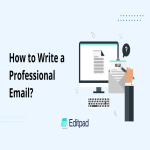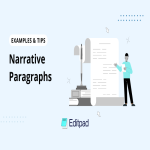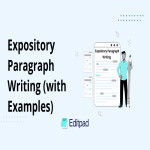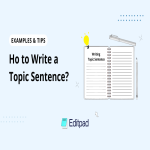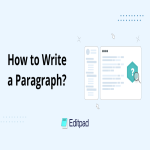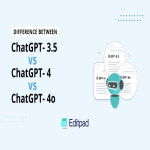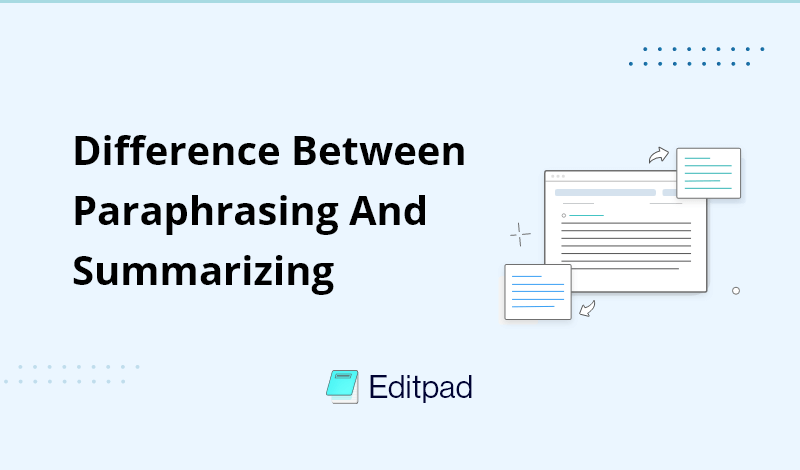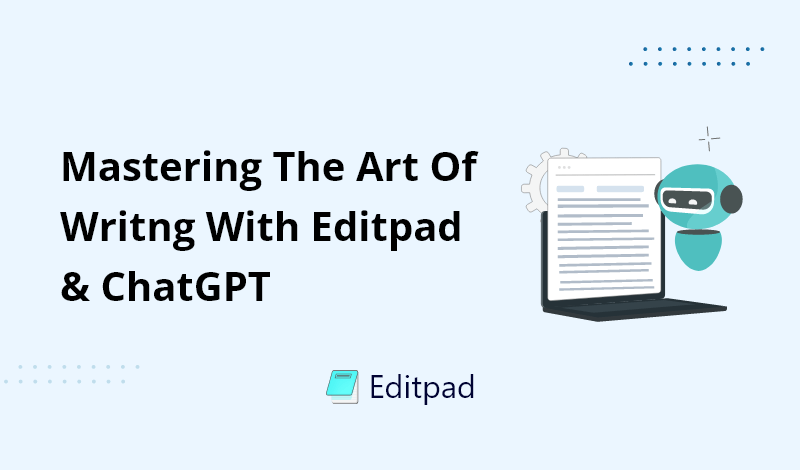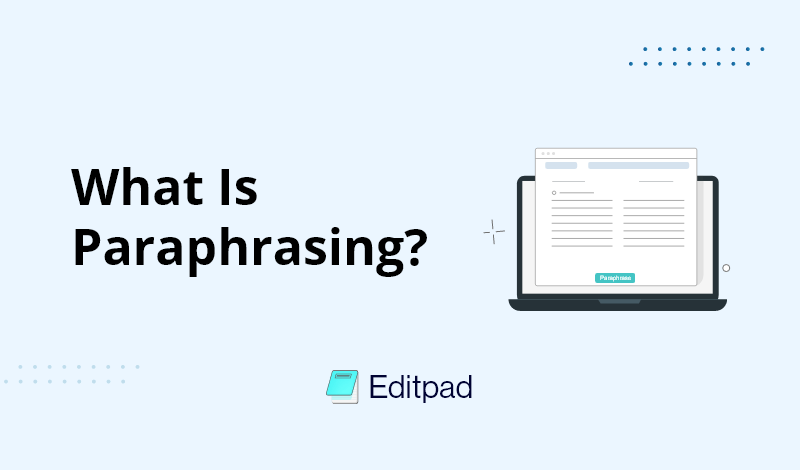A paragraph is a collection of sentences that convey a single meaning. It normally starts from a topic sentence that relays the main idea to the reader – what the paragraph is about.
Paragraphs are necessary to break down work in a more sensible manner. Each idea is expressed in a new paragraph, improving the reading experience.
Many field professionals, educators, and students need written communication to express their thoughts and ideas. They must create pieces with high coherency and clarity. Hence, they must know how to structure their work and create quality paragraphs.
In this post, we’ll show you the procedure of writing a quality paragraph. By following our guidelines, you’ll be able to connect with the audience, effectively.
First, you need to learn about the type of paragraphs to write according to your audience and different situations. There are many types of paragraphs, but the most common ones are below.
In a Narrative paragraph type, the writer sets the scene and tells the reader about the incidents that they witnessed. This type of para consists of chronologically developed points that leads the reader through an event.
However, seeing is believing and we’ll take an example from Editpad’s Paragraph Generator to show you how it’s done.
Given Prompt:
“Write a narrative paragraph that connects to the main topic of a sunset in Edinburgh’”
Editpad Paragraph Generator Output:
| "John had always dreamed of visiting Edinburgh, and on his first evening in the city, he found himself walking up to Calton Hill. As he reached the top, he was greeted by the most stunning sunset he had ever seen. The sky was painted in shades of orange and pink, casting a warm glow over the entire city. Edinburgh's old buildings and the castle on the hill seemed to come alive in the soft light. John felt a sense of peace and wonder as he stood there, taking in the beauty around him. This sunset in Edinburgh was everything he had hoped for, and he knew he would remember this moment for the rest of his life." |
Output Image:
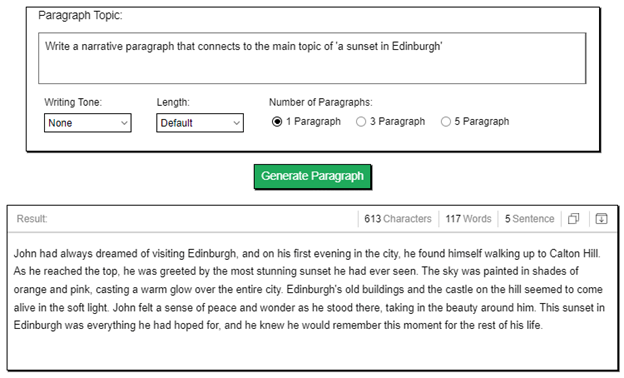
As we can see, the paragraph is written in a third-person perspective, guiding the audience through John’s journey. The paragraphs and sentences are written in a very reader-friendly way, making it easier for people to understand everything.
Another type of paragraph is descriptive, which is used to sketch a place, object, or person in detail.
Descriptive paragraphs mostly appeal to the 5 human senses of see, smell, taste, listen, and touch. These elements bring a connection with the audience as they can feel what you can feel.
Once again, we’ll use the paragraph generator to show you a pictorial demonstration of the said para type.
Output Image:
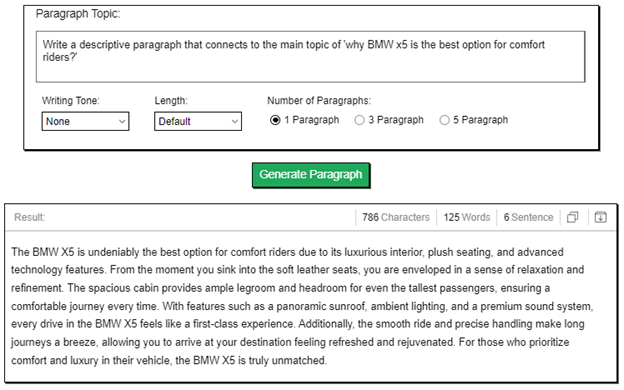
We are far more impressed with this output than the previous one. The tool has covered the car in depth and explained to the users why it’s best for day-to-day comfort rides.
The details in descriptive paragraphs are much more vivid and real than other paragraph types. However, take special care about the level of reading difficulty you add with each layer of description.
We don’t want to make paragraphs a nightmare for the reader! It should be clear what you want to describe, and how does it relate to the main topic of the document.
In Persuasive paragraphs, you have to convince a reader about your viewpoint or stance. So, you start shallow and build upon a given statement.
This type of paragraph can include rhetorical questions, dramatic comparisons, appeal to emotion, etc. The main goal is to do enough so that the audience is compelled to take the action you require from them.
These types of paragraphs are highly popular in content marketing. Marketers convince their target audience through emails, blogs, etc., to buy or at least consider their provided offerings.
Example:
“Write a persuasive paragraph that connects to the main topic of 'Is it necessary to wear uniforms in schools?"
Output:
| "Wearing uniforms in schools is not just a matter of fashion or preference; it is a necessary component of creating a positive and productive learning environment. When students are dressed in the same attire, it eliminates distractions and allows them to focus on their studies rather than worrying about what their peers are wearing. Uniforms also promote a sense of unity and equality among students, regardless of their socio-economic background. By removing visible markers of status or wealth, uniforms help to level the playing field and reduce instances of bullying or discrimination based on clothing. Additionally, uniforms instill a sense of discipline and pride in students, as they are representing their school in a professional manner. Overall, the implementation of uniforms in schools is a vital tool in creating a safe and inclusive educational setting for all students." |
This paragraph is also generated from Editpad’s AI Paragraph Generator. However, this time we changed some settings in the AI-based web-app to get better results.
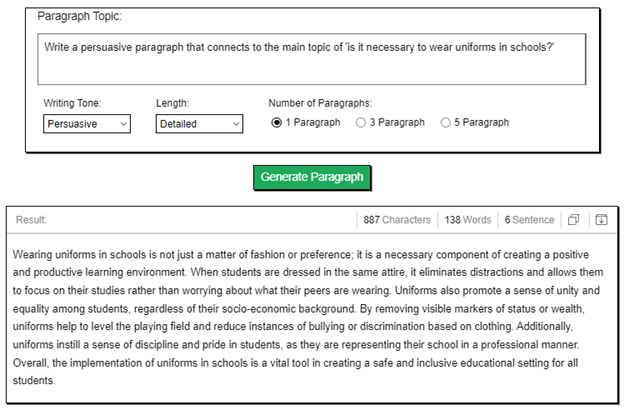 Before this, we didn’t change the ‘Writing Tone’ and ‘Length’ modes. However, to fully express the convincing power to the readers, it was must to change the tone to persuasive and the length to detailed, while a number of paragraphs remained constant at ‘1.’
Before this, we didn’t change the ‘Writing Tone’ and ‘Length’ modes. However, to fully express the convincing power to the readers, it was must to change the tone to persuasive and the length to detailed, while a number of paragraphs remained constant at ‘1.’
Consequently, the paragraph argued in favor of the topic of implementing uniforms in schools, and had enough convincing attitude (with provided factors) to make the audience agreeable.
Expository is the most common paragraph type where we explain a definition, sub-topic, or concept to the audience.
These types of paragraphs are mostly used in educative essays, reports, or academia in general. They relay information to the readers in a consistent manner where each line looks to add value.
To generate an example from Editpad's AI Paragraph Writer, we’ll use the following settings: A) Direct tone, B) Detailed length, and C) 1 paragraph. Below are the results we got.
Given Prompt:
“Write an expository paragraph that connects to the main topic of 'significance of AI in content marketing.'”
Output:
| “The significance of AI in content marketing cannot be overstated. AI technology has revolutionized the way businesses create, distribute, and analyze content. With AI-powered tools, companies can now personalize their content at scale, ensuring that each individual consumer receives relevant and engaging information. This level of customization not only enhances the customer experience but also increases the likelihood of conversion. Additionally, AI can help marketers identify trends and patterns in data, allowing them to create more effective content strategies. By leveraging AI, businesses can stay ahead of the competition and connect with their target audience in a more meaningful way. In conclusion, AI is not just a tool for efficiency - it is a game-changer for content marketing.” |
Output Image:
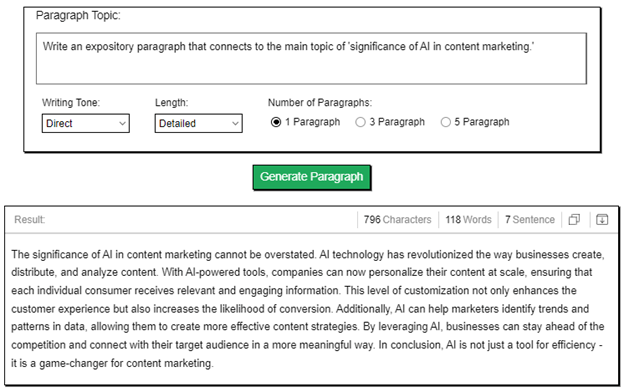
The tool has accurately elaborated on the importance of AI in content marketing. It gave reasons like ‘AI helping in analyzing trends in data’ which is true on many accounts. The paragraph also concluded with the introductory sentencing starting from ‘In conclusion.’
This shows that the web-app is smart enough to create a decent structure of the paragraph that allows easy indexing of information. Following this strategy, you can write compelling pieces of text for the readers and gain their support on your side.
Talking of structure, let’s analyze the elements that a good paragraph must have. A good paragraph, no matter its type, must always start with a topic sentence. This one line explains what the paragraph will discuss, giving readers an estimate of what’s to come.
Then, the para must traverse into the supporting sentences that back the introductory line sensibly. These sentences must contain relevant evidence or examples to confirm the point.
Also, you should cite facts from authority sources to prove their validity to the audience and build your trust upon them.
Finally, the idea of the paragraph must conclude and relate back to the main topic of the document. This will ensure coherence or logical consistency in your work.
Interestingly, what we just discussed is the TEAR structure for a paragraph that many follow to attract audiences to their posts. The acronym TEAR stands for:
As discussed earlier, we must back the topic sentence by giving relevant evidence. Then, discuss upon them (analysis), while finally relating back to the main topic.
However, when it comes to defining an ideal length of a paragraph, there isn’t a clear guideline.
According to our research, paragraphs must be around 5 sentences with a total word count of around 100 words each. The paragraph must contain an introductory line (topic sentence), 2-3 supporting sentences, and a concluding line.
Still, these guidelines are not hard and fast rules. Paragraph length and number of sentences and their length can all vary according to the situation and requirements of your content.
Now that we’ve reviewed the types and essential elements of a paragraph, it’s about time we learn how to write one.
First things first, your research for the whole document must be comprehensive. Study the main topic from multiple resources and develop a thesis statement (don’t confuse this with a topic sentence.)
Then, you must learn about the audience to whom you have to deliver your points and decide about the paragraph type you’ll use.
Example Topic:
“Benefits of using sugar alternatives”
These types of topics tend to educate the reader with new knowledge and explanations of different phenomena. Hence, the essay or report would contain expository paragraphs.
However, sometimes writers have to mix up the paragraph types to accomplish business goals. For instance, a travel agency firm may use a mix of persuasive and descriptive paragraph types to encourage more travelers to visit a place.
To make the TEAR structure work, you need to use transition words like, ‘Furthermore', ‘Consequently’, ‘In addition’ etc., in the paragraphs. These words maintain cohesion between the sentences and coherence in the overall work.
Transition words also help connect the thoughts in each paragraph and appreciate the rhythmic reading for the audience.
However, these processes just seem too difficult for some writers to follow. Thus, using Editpad’s Paragraph Writer is a good way to learn the basics of paragraph writing.
As you’ll see from the pictorial demonstration below, the tool accurately uses the TEAR structure and transition words together to make work remarkable.
Given Prompt:
"Write a paragraph that connects to the main topic of ‘technology is harming us."
Output Result:
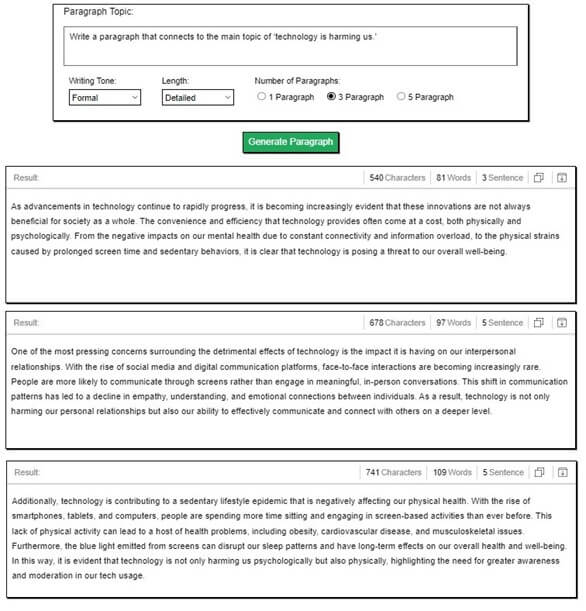
There’s a reason we increased the number of paragraphs to 3. We wanted to see how well the tool connects thoughts with other paras using transition words.
Evidently, the paragraph generator has successfully implemented all the guidelines we’ve discussed so far. The paragraphs are at most 5 sentences in length and there is an eloquent use of transition words.
For example, the first line of the third para starts with the word ‘Additionally.’ This is quite a good technique to start a topic sentence and connect ideas with the previous paragraph.
Another instance of the use of transition words can be seen in the fourth line of the second paragraph ‘As a result’, and so no. These words surely improve readability by smoothing out contrasting points and avoiding any abrupt changes in the flow of the paragraph.
According to TEAR, it’s not only important to give pieces of evidence after the topic sentence, but also to elaborate on them.
Meaning, that you should explain to the readers how a cited fact relates to your argument or main point. And, highlight the significance of the said words in the light of the overall stance or thesis statement.
As always, when you’re explaining the evidence, keep using transition words and repeating the supporting sentences until your point is fully established. Proofread your paragraph to check if everything written makes sense or not.
Lastly, move on to the concluding line to end the paragraph and take the discussion forward.
The last one or two must contain the crux of the entire paragraph. It should summarize the entire findings, research, and evidence discussed before and convert them to key takeaways for the audience.
Conclusion line(s) are important for a paragraph to retain the attention of “busy customers.” These are the types of people who skim entire content by only viewing the entry and exit lines of a paragraph.
Hence, to capture and cater to various needs and types of users, writing concise conclusions becomes critical.
However, it’s not necessary to end the paragraph with its summary. Sometimes, writers would introduce a weak argument in the end so that they can build upon it in the upcoming paragraphs. This technique keeps the reader engaged with the content.
In this post, we saw the complete way to write a paragraph. We learned about the different paragraph types and their use cases in multiple scenarios.
We also learned that a solid paragraph structure is necessary to maintain coherence in thoughts and successfully deliver points to the readers.
It is also useful to implement transition words wherever possible choose a suitable paragraph length and type and stick to it throughout the text.
That’s all from our side! We hope you enjoyed reading our content!
